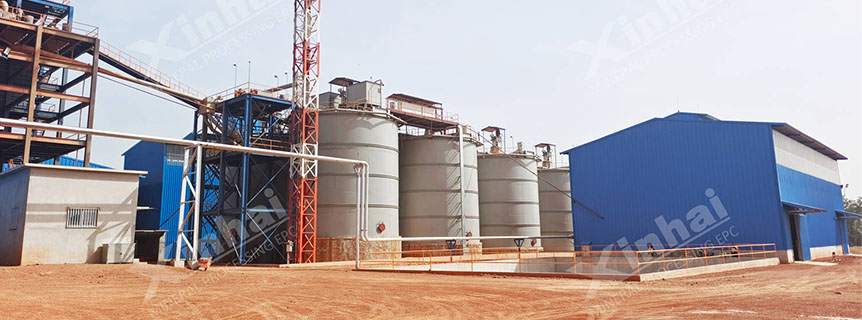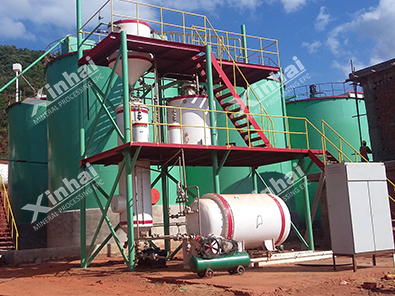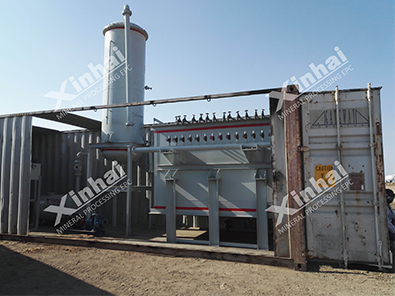Gold Ore CIP Process Flow Explained: Techniques for Efficient Extraction
 Laura
Laura
 Aug 14, 2024
Aug 14, 2024
 3707
3707
If you want to know more details about equipment, solutions, etc, please click the button below for free consultation, or leave your requirements!

Guinea 3000tpd Gold Ore CIP Processing Plant
The world of gold mining is as intricate as it is fascinating. Among the various methods employed to extract gold from its ore, the Carbon in Pulp (CIP) process stands out for its efficiency and effectiveness. This article delves into the gold ore CIP process flow, highlighting its techniques and the steps involved in ensuring optimal gold extraction.
01What is CIP?
BackCIP, or Carbon in Pulp, is a gold extraction technique that utilizes activated carbon to separate gold from the ore slurry. The process involves leaching gold from crushed ore using a cyanide solution, followed by the absorption of the gold-cyanide complex onto activated carbon. This method has gained popularity due to its cost-effectiveness and high recovery rates.
02Why Choose CIP?
BackThe advantages of the CIP process are numerous. It is particularly effective for low-grade ores, where traditional methods might fail to yield adequate returns. Additionally, CIP allows for the simultaneous leaching and absorption of gold, reducing the overall processing time. The method also minimizes the need for expensive equipment, making it a popular choice among mining operations worldwide.
03Gold Ore CIP Process Flow
BackThe CIP process can be broken down into several key stages, each of which plays a crucial role in the overall efficiency of gold extraction. Here’s a detailed look at each stage:
1. Crushing and Grinding
The first step in the CIP process involves the crushing and grinding of gold ore. This is essential to liberate the gold particles from the surrounding material. The ore is typically crushed to a size of 1 to 2 inches, followed by grinding in a ball mill to achieve a finer particle size of about 75 microns or less. This increased surface area facilitates better interaction with the cyanide solution during leaching.
2. Leaching
Once the ore is sufficiently crushed and ground, it is mixed with a cyanide solution in large leaching tanks. The cyanide reacts with the gold, forming a soluble gold-cyanide complex. This process takes place over several hours to days, depending on factors such as the ore's characteristics, cyanide concentration, and temperature. The leaching process is critical, as it determines the amount of gold that can be extracted from the ore.
3. Carbon Adsorption
After leaching, the slurry containing the gold-cyanide complex is transferred to a series of adsorption tanks. Here, activated carbon is introduced. The gold-cyanide complex adheres to the carbon particles, allowing for the separation of gold from the slurry. The efficiency of this step is influenced by factors such as the type of activated carbon used, contact time, and the concentration of gold in the solution.
4. Desorption
Once the carbon is saturated with gold, it undergoes a desorption process. This involves stripping the gold from the carbon using a hot caustic solution or a concentrated cyanide solution. The desorption process typically occurs in a separate vessel, where the gold is recovered in a more concentrated form.
5. Electrowinning
After desorption, the gold solution is subjected to electrowinning. This process involves passing an electric current through the solution, causing gold to be deposited onto cathodes. The gold is then stripped off the cathodes, resulting in a high-purity gold product. This step is crucial for achieving the desired purity levels and is often followed by further refining processes.
6. Regeneration of Carbon
To ensure the sustainability of the CIP process, it is essential to regenerate the activated carbon used in the adsorption stage. This is typically done by treating the carbon with a hot caustic solution to remove impurities and restore its adsorption capacity. Regeneration not only enhances the efficiency of the process but also reduces the overall operational costs.
7. Tailings Management
After the gold has been extracted, the remaining slurry, known as tailings, must be properly managed. Tailings may contain residual cyanide and other hazardous materials, requiring careful handling to prevent environmental contamination. Many operations implement tailings management strategies, such as detoxification processes or secure storage facilities, to mitigate these risks.
04Techniques for Efficient Extraction
BackWhile the CIP process is inherently efficient, several techniques can be employed to further enhance gold extraction rates. Here are some strategies that mining operations can implement:
1. Optimizing Cyanide Concentration
The concentration of cyanide in the leaching solution plays a critical role in the efficiency of gold extraction. Conducting tests to determine the optimal cyanide concentration can lead to improved recovery rates and reduced costs.
2. Temperature Control
Maintaining the right temperature during leaching can significantly impact the reaction kinetics. Higher temperatures generally increase the solubility of gold in cyanide, leading to faster leaching times. However, care must be taken to avoid exceeding safe limits, which could lead to environmental issues.
3. Particle Size Management
As mentioned earlier, the particle size of the ore is crucial for effective leaching. Regular monitoring and adjustment of the grinding process can ensure that the ore is consistently within the optimal size range for maximum gold extraction.
4. Carbon Selection
Choosing the right type of activated carbon is vital for successful adsorption. Different carbons have varying adsorption capacities and affinities for gold. Regular testing and selection of high-quality carbon can enhance the efficiency of the CIP process.
5. Continuous Monitoring and Automation
Implementing automated systems for monitoring key parameters, such as pH, cyanide concentration, and temperature, can help maintain optimal conditions throughout the CIP process. This level of control can lead to improved operational efficiency and increased gold recovery.
05Conclusion
BackThe Gold Ore CIP process is a sophisticated yet efficient method for extracting gold from ore. Understanding the various stages of the process and implementing techniques for optimization can significantly enhance gold recovery rates. As the mining industry continues to evolve, the CIP process remains a cornerstone of gold extraction, paving the way for sustainable and profitable mining operations. By continuously refining these techniques, mining companies can maximize their yield while minimizing environmental impact, ensuring a brighter future for the gold mining industry.
Contact us and learn more about Gold CIP Process Flow.
 +86 183 3575 8886
+86 183 3575 8886 pinklaurabao@gmail.com
pinklaurabao@gmail.com




 Message
Message Chat Now
Chat Now




















